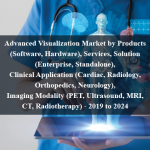OVERVIEW
The Healthcare Middleware Market is currently valued at USD 3.2 billion in 2024 and will be growing at a CAGR of 9.87% over the forecast period to reach an estimated USD 5.05 billion in revenue in 2029. Healthcare middleware serves as the vital bridge between various healthcare IT systems, enabling seamless communication and data exchange across disparate platforms. It acts as a mediator, facilitating interoperability between electronic health records (EHRs), laboratory information systems (LIS), picture archiving and communication systems (PACS), and other healthcare applications. By standardizing data formats and protocols, middleware solutions streamline the integration process, allowing healthcare organizations to leverage data from multiple sources for clinical decision-making, analytics, and reporting. Additionally, middleware platforms often incorporate advanced functionalities such as data transformation, routing, and security protocols to ensure the secure and efficient transmission of sensitive patient information. As healthcare systems become increasingly complex and interconnected, healthcare middleware plays a crucial role in optimizing workflows, enhancing interoperability, and ultimately improving patient care outcomes.
The healthcare middleware market is experiencing significant growth, driven by several key factors. One major driver is the increasing adoption of electronic health records (EHR) and other healthcare IT systems, which require middleware solutions to facilitate seamless integration and interoperability among disparate systems. Additionally, the growing volume of healthcare data, fueled by advancements in medical imaging, genomics, and wearable devices, is creating a demand for middleware platforms capable of efficiently managing and processing large datasets. Furthermore, the emphasis on value-based care and population health management is driving healthcare organizations to invest in middleware solutions that enable real-time data analytics and decision support, empowering clinicians to deliver more personalized and proactive care. Moreover, the rising importance of patient engagement and telehealth services is spurring the need for middleware solutions that can securely connect patients, providers, and various healthcare applications across different settings and devices.
Market Dynamics
Drivers:
The healthcare middleware market is experiencing significant growth, driven by several key factors. One major driver is the increasing adoption of electronic health records (EHR) and other healthcare IT systems, which require middleware solutions to facilitate seamless integration and interoperability among disparate systems. Additionally, the growing volume of healthcare data, fueled by advancements in medical imaging, genomics, and wearable devices, is creating a demand for middleware platforms capable of efficiently managing and processing large datasets. Furthermore, the emphasis on value-based care and population health management is driving healthcare organizations to invest in middleware solutions that enable real-time data analytics and decision support, empowering clinicians to deliver more personalized and proactive care. Moreover, the rising importance of patient engagement and telehealth services is spurring the need for middleware solutions that can securely connect patients, providers, and various healthcare applications across different settings and devices
Key Opportunities :
The healthcare middleware market presents numerous key opportunities for growth and innovation. One significant opportunity lies in leveraging artificial intelligence (AI) and machine learning (ML) technologies to enhance middleware platforms with advanced analytics, predictive modeling, and decision support capabilities. These AI-powered solutions can enable healthcare organizations to derive actionable insights from vast amounts of data, driving improvements in clinical outcomes, operational efficiency, and cost management. Additionally, the proliferation of Internet of Things (IoT) devices and wearable technologies offers opportunities to expand middleware functionalities for remote patient monitoring, chronic disease management, and personalized healthcare delivery. Moreover, with the increasing focus on interoperability and data exchange, there is a growing need for middleware solutions that can seamlessly integrate with emerging standards and interoperability frameworks, facilitating secure and efficient data sharing across healthcare systems and stakeholders. Furthermore, as healthcare moves towards value-based care models, there is a rising demand for middleware platforms that support care coordination, population health management, and patient engagement initiatives, enabling healthcare organizations to optimize care delivery and improve patient outcomes while reducing costs.
Restraints :
One notable challenge is the complexity and fragmentation of healthcare IT systems, which can hinder the seamless integration and interoperability that middleware solutions aim to facilitate. Legacy systems, disparate data formats, and varying interoperability standards present obstacles to effective data exchange and workflow integration, requiring middleware vendors to navigate a complex landscape of compatibility issues. Additionally, concerns around data privacy, security, and regulatory compliance pose significant restraints on middleware adoption, particularly as healthcare organizations grapple with increasingly stringent data protection regulations such as HIPAA and GDPR. Moreover, budget constraints and resource limitations may impede investments in middleware solutions, particularly for smaller healthcare providers and organizations with limited IT infrastructure and expertise. Furthermore, the rapid pace of technological innovation and evolving industry standards pose challenges for middleware vendors to keep pace with changing market dynamics and customer requirements, necessitating ongoing investment in research and development to stay competitive.
Regional Information:
• In North America, the healthcare middleware market is propelled by several factors, including the widespread adoption of electronic health records (EHRs), stringent regulatory mandates such as the Health Insurance Portability and Accountability Act (HIPAA), and the presence of a robust healthcare IT infrastructure. Additionally, increasing investments in healthcare IT modernization, growing demand for interoperable systems to facilitate care coordination and population health management, and the rising prevalence of chronic diseases are driving market growth in the region. Moreover, North America is witnessing a surge in telehealth adoption, further fueling the demand for middleware solutions that enable seamless integration of virtual care platforms with existing healthcare systems.
• In Europe, the healthcare middleware market is influenced by a combination of factors, including the implementation of initiatives such as the European Union’s General Data Protection Regulation (GDPR) and the Digital Health Society (DHS) to promote interoperability and data exchange across member states. Moreover, the region’s aging population, increasing healthcare expenditures, and emphasis on personalized medicine are driving the adoption of middleware solutions to support data-driven decision-making and improve patient outcomes. Additionally, Europe’s strong focus on healthcare innovation and research, coupled with collaborations between public and private stakeholders, is fostering the development of advanced middleware platforms tailored to the region’s unique healthcare needs and regulatory requirements.
• In the Asia Pacific region, the healthcare middleware market is experiencing rapid growth driven by factors such as the expansion of healthcare infrastructure, rising healthcare spending, and government initiatives aimed at digital transformation of healthcare delivery. Countries like China, India, and Japan are witnessing significant investments in healthcare IT infrastructure and interoperability standards to support the integration of healthcare systems and facilitate data exchange. Moreover, the increasing adoption of telemedicine, mobile health technologies, and wearable devices is creating opportunities for middleware vendors to provide solutions that enable seamless connectivity and data sharing across disparate platforms.
Recent Developments:
• In March 2022, COPE Health Solutions and its Analytics for Risk Contracting (ARC) subsidiary have partnered with CareJourneyto provide one of the first health analytics platforms and solutions that integrate a health care organization’s claims, electronic health records, lab, social determinants, and other data with CareJourney’s suite of cost and utilization benchmarks derived on Medicare and Medicaid datasets.
• In April 2021, 3M Health Information Systems announced the launch of a new technology platform that can assist healthcare providers and payers in the prioritization of patient care and resource allocation.
Key Market Players:
Cerner Corporation, Epic Systems Corporation, Allscripts Healthcare Solutions, Inc. InterSystems Corporation, IBM Corporation, Orion Health Group Limited, FUJIFILM Medical Systems, GE Healthcare, Siemens Healthineers
1) What is the projected market value of the Healthcare Middleware Market?
– The Healthcare Middleware Market is expected to reach an estimated value of USD 5.62 billion in revenue by 2029.
2) What is the estimated CAGR of the Healthcare Middleware Market over the 2024 to 2029 forecast period?
– The CAGR is estimated to be 15.1% for the Healthcare Middleware Market over the 2024 to 2029.
3) Who are the key players in the Healthcare Middleware Market?
– Cerner Corporation, Epic Systems Corporation, Allscripts Healthcare Solutions, Inc. InterSystems Corporation, IBM Corporation, Orion Health Group Limited, FUJIFILM Medical Systems, GE Healthcare, Siemens Healthineers
4) What are the drivers for the Healthcare Middleware Market?
– The healthcare middleware market is growing due to the adoption of electronic health records, growing healthcare data volume, value-based care, population health management, and patient engagement. Middleware solutions facilitate seamless integration, manage large datasets, enable real-time data analytics, and connect patients, providers, and healthcare applications across different settings and devices.
5) What are the restraints and challenges in the Healthcare Middleware Market?
– The complexity and fragmentation of healthcare IT systems pose challenges to middleware solutions, including compatibility issues, data privacy, security, regulatory compliance, budget constraints, and resource limitations. Additionally, the rapid pace of technological innovation and evolving industry standards necessitates ongoing investment in research and development to stay competitive and meet changing market dynamics and customer requirements.
6) What are the key applications and offerings of the Healthcare Middleware Market?
Cerner Corporation, Epic Systems Corporation, Allscripts Healthcare Solutions, Inc. InterSystems Corporation, IBM Corporation, Orion Health Group Limited, FUJIFILM Medical Systems, GE Healthcare, Siemens Healthineers
7) Which region is expected to drive the market for the forecast period?
– North America is expected to have the highest market growth from 2024 to 2029
Why Choose Us?
Insights into Market Trends: Global Market Studies reports provide valuable insights into market trends, including market size, segmentation, growth drivers, and market dynamics. This information helps clients make strategic decisions, such as product development, market positioning, and marketing strategies.
Competitor Analysis: Our reports provide detailed information about competitors, including their market share, product offerings, pricing, and competitive strategies. This data can be used to inform competitive strategies and to identify opportunities for growth and expansion.
Industry Forecasts: Our reports provide industry forecasts, which will inform your business strategies, such as investment decisions, production planning, and workforce planning. These forecasts can help you to prepare for future trends and to take advantage of growth opportunities.
Access to Industry Experts: Our solutions include contributions from industry experts, including analysts, consultants, and subject matter experts. This access to expert insights can be valuable for you to understand the market.
Time and Cost Savings: Our team at Global Market Studies can save you time and reduce the cost of conducting market research by providing comprehensive and up-to-date information in a single report, avoiding the need for additional market research efforts.












